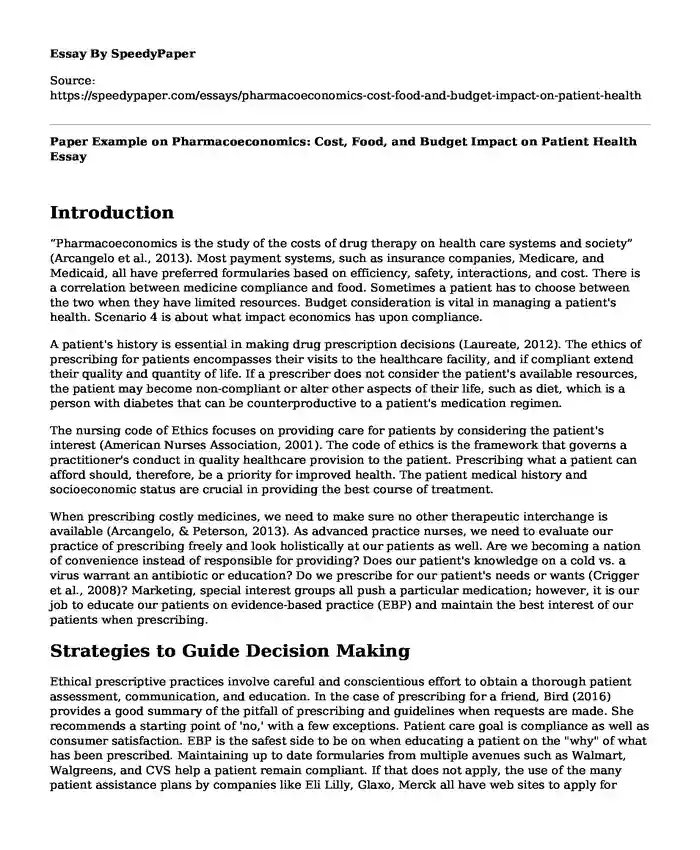
| Type of paper: | Essay |
| Categories: | Management Pharmacology |
| Pages: | 3 |
| Wordcount: | 691 words |
Introduction
“Pharmacoeconomics is the study of the costs of drug therapy on health care systems and society” (Arcangelo et al., 2013). Most payment systems, such as insurance companies, Medicare, and Medicaid, all have preferred formularies based on efficiency, safety, interactions, and cost. There is a correlation between medicine compliance and food. Sometimes a patient has to choose between the two when they have limited resources. Budget consideration is vital in managing a patient's health. Scenario 4 is about what impact economics has upon compliance.
A patient's history is essential in making drug prescription decisions (Laureate, 2012). The ethics of prescribing for patients encompasses their visits to the healthcare facility, and if compliant extend their quality and quantity of life. If a prescriber does not consider the patient's available resources, the patient may become non-compliant or alter other aspects of their life, such as diet, which is a person with diabetes that can be counterproductive to a patient's medication regimen.
The nursing code of Ethics focuses on providing care for patients by considering the patient's interest (American Nurses Association, 2001). The code of ethics is the framework that governs a practitioner's conduct in quality healthcare provision to the patient. Prescribing what a patient can afford should, therefore, be a priority for improved health. The patient medical history and socioeconomic status are crucial in providing the best course of treatment.
When prescribing costly medicines, we need to make sure no other therapeutic interchange is available (Arcangelo, & Peterson, 2013). As advanced practice nurses, we need to evaluate our practice of prescribing freely and look holistically at our patients as well. Are we becoming a nation of convenience instead of responsible for providing? Does our patient's knowledge on a cold vs. a virus warrant an antibiotic or education? Do we prescribe for our patient's needs or wants (Crigger et al., 2008)? Marketing, special interest groups all push a particular medication; however, it is our job to educate our patients on evidence-based practice (EBP) and maintain the best interest of our patients when prescribing.
Strategies to Guide Decision Making
Ethical prescriptive practices involve careful and conscientious effort to obtain a thorough patient assessment, communication, and education. In the case of prescribing for a friend, Bird (2016) provides a good summary of the pitfall of prescribing and guidelines when requests are made. She recommends a starting point of 'no,' with a few exceptions. Patient care goal is compliance as well as consumer satisfaction. EBP is the safest side to be on when educating a patient on the "why" of what has been prescribed. Maintaining up to date formularies from multiple avenues such as Walmart, Walgreens, and CVS help a patient remain compliant. If that does not apply, the use of the many patient assistance plans by companies like Eli Lilly, Glaxo, Merck all have web sites to apply for prescription assistance towards more costly medications
The basis for a prescription is to provide a patient with better healthcare without financial constraints. When prescribing, it is important to consider patients need attainable care, advocating the use of generics as well as alternative therapies (Choudhry, 2016). Prescriptive authority for the nurse practitioner has many ethical as well as the legal insinuations that impact multiple stakeholders. Understand prescriber responsibilities include ethical and practical considerations and responsible decision-making.
References
American Nurses Association. (2001). Code of ethics for nurses with interpretive statements. Nursing World. http://www.nursingworld.org/MainMenuCategories/EthicsStandards/CodeofEthicsforNurses/Code-of-Ethics-For-Nurses.html.
Arcangelo, V. P., & Peterson, A. M. (Eds.). (2013). Pharmacotherapeutics for advanced practice: A practical approach (3rd ed.). Ambler, PA: Lippincott Williams & Wilkins.
Choudhry, N. K., Denberg, T. D., & Qaseem, A. (2016, January 05). Improving Adherence to Therapy and Clinical Outcomes While Containing Costs: Opportunities From the Greater Use of Generic Medications: Best Practice Advice From the Clinical Guidelines Committee of the American College of Physicians Opportunities From the Greater Use of Generic Medications. http://annals.org/aim/article/2471597/improving-adherence-therapy-clinical-outcomes-while-containing-costs-opportunities-from
Crigger, N., & Holcomb, L. (2008). Improving nurse practitioner practice through rational prescribing. The Journal for Nurse Practitioners, 4(2), 120-125.
EliLilly. (2017). Prescription Assistance Plans. Retrieved from: https://www.pparx.org/prescription_assistance_programs/lilly_cares
Laureate Education, Inc. (Executive Producer). (2012). Introduction to advanced pharmacology. Baltimore, MD: Author.
Cite this page
Paper Example on Pharmacoeconomics: Cost, Food, and Budget Impact on Patient Health. (2023, Aug 26). Retrieved from https://speedypaper.com/essays/pharmacoeconomics-cost-food-and-budget-impact-on-patient-health
Request Removal
If you are the original author of this essay and no longer wish to have it published on the SpeedyPaper website, please click below to request its removal:
- 7 Things a Good Student Should Do, Essay Example
- Essay Sample: Tort Reform in the Field of Medical Malpractice
- Free Essay Sample on Register Patients
- Essay Sample on Literature Search, Rapid Critical Appraisal, and Summarization
- Free Essay: Sick Around the World Online Video Essay
- Critical Infrastructure - Free Essay Sample
- The Effects of Parental Education in the Health and Nutrition of African American Children - Essay Sample
Popular categories




